
|   |

|   |
 e-mail: leelakaverivenkat@gmail.com Dance sonnets to the sun god at Konark Photos courtesy: Odisha Tourism December 16, 2018 Standing in isolated grandeur is Odisha's Konark temple, a stone paean to the Sun God, its tower despite centuries of sea winds chipping away layers from the glorious surasundaris sculpted on its walls, raising a silent toast to the artistic genius of India's ancient sculptors. Konark is more than just a temple monument. Over the years, its image has become the identity of Odisha. This normally quiet township, beckoning tourists with its temple site and unspoilt beaches, turns into an activity hub during the week long annual dance festival mounted by the Odisha Tourism Department in association with the OTDC and Odisha Sangeet Natak Akademi, supported by Utkal University of Culture and the Kelucharan Sangeet Research Centre BBSR. The open air theatre, with galleried seating, with a massive stage on two tiers, with the top of the magnificent temple tower as backdrop a short distance away, is perhaps one of the most glorious performance spaces in India for dance groups. On one side as if, presiding over the festivities are installed the artistically crafted figures of Jagannath, Balabhadra and Subhadra at whose feet chief guests offer homage by lighting the ceremonial lamp every evening during the inauguration ceremony. The week offers more for those interested in a late night Jatra group presentation and of course the government sponsored Sand Festival on the beach, with foreign and Indian artists participating in creating images expressing a new theme every day. And with trees and roads, not to speak of government guest houses like the Pant Nivas colourfully lit, with the walk-up from the gate to the performance arena sporting the most artistic rangoli patterns, this government sponsored event, spares no effort in evoking the true feel of a carnival. A drone camera circling over the performance site, (replacing the long armed intrusive camera obstructing audience viewers previously) photographs proceedings for a simultaneous DD Bharati broadcast and here is one festival where State patronage, in intent, has not diluted over the years. Different dance traditions are presented, with special emphasis, justifiably, on Odissi which forms one half of the programme every evening. 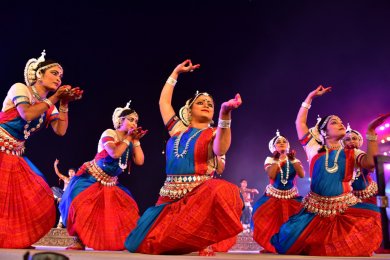 Nrutyayan Doing full justice as a curtain-raiser to this grand festival was the presentation by Durga Charan Ranbir's Nrutyayan group. The philosophical start with Shankaracharya's Nirvana Shatakam extolling the non-dual, formless, state of Chitananda roopam with the realisation that the Brahman is within oneself. Shivoham Shivoham (Shiva+aham) saw some of the most painstakingly organised group formations with well groomed dancers. The Debaprasad gharana, in its meditative minimalism, was diligently harnessed by Durga Charan Ranbir - the plethora of bhramaris, strong chauka, and yogasanas (particularly suited to the well balanced male body) rendered in rare unison by the male dancers with Rahul Acharya making a particularly convincing Krishna, and male costuming too showed a feel for aesthetics. The getup for the female dancers though, had too many loud colours clashing with the main white. The Keerwani Pallavi by Ramahari Das in Durga Charan's choreographic group images blossomed. The last item Samba Upakhyana had (as the opening 'Shivoham Shivoham'), scholar Nityananda Misra's researched libretto and music by Ramahari Das with Dhaneswar Swain contributing the nritta inputs. The episode is woven round Krishna's tempestuous son Samba born to Jambhavati. Trespassing into the privacy of Krishna's bed chamber when he was isolated with his main queens Rukmini and Satyabhama, Samba incites his father's curse to become a leper, till Narada's intervention of a cure comprising twelve years of deep meditation and prayer to Surya, rids him of the curse nursing him back to normalcy. The delicate sringar scene of Krishna with his eight principal queens, the meditating scene with difficult Hathayoga frozen stances, and the group images in final sonorous prayer and thanksgiving, abounding in frozen Surya images, ending with Moksha were incredibly well synchronised. The present trend is to burden the musical accompaniment with far too many participants - whereas a leaner team with fewer musicians can create more effective mood build-up, without too many interventions. Here too the lone female voice stepping in at a point was out of sruti. 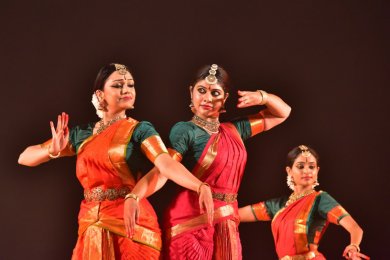 Rama Vaidyanathan & group Following on the heels of such a fine performance, Rama Vaidyanathan's Bharatanatyam group did not allow the evening to sag, the entire performance resting on excellent music, led by Sudha Raghuraman's flawlessly soaring vocal cords, moving with silken ease amidst octaves. To the strains of Rasikapriya, the breezy entry with Rama and her daughter Dakshina set the pace for Devi Stuti with the group of finished dancers appearing one behind the other. Tastefully simple, the orange costume with green blouse teamed with a minimum of jewellery, allowed group formations to stand out and to the beeja mantras 'Om aim hreem shreem', the Devi as Rudraroopini in the fiery glow (jwalamukhi) of her glory was brought out through movement dotted with dramatic freezes - the strongly executed movement passages, covering stage space. Sudha's involved, ecstatic singing in Gaula, in Surati, in Hamsanandi and finally Revati, with Vasudevan's nattuvangam verve, mridangam by Sumod Sreedharan and flute and violin by Raghuraman and Biju Anand respectively, provided excellent support. Rama has evolved her own style of group choreography, making an oft rendered Keertanam by Swati Tirunal, "Visweswara darshana kare chal man tum Kashi…" in Sindhu Bhairavi exhorting people to go to Kashi to see the Ganga and pay homage to Kashi Vishwanath, not look hackneyed. Spinning each segment into memorable images like Bhasma Anga Shiva in ash smeared glory accompanied by the knife edged bols "Damad Damad, Damad", dilating on Ganga's battle of wills with Shiva while descending on earth, till she is contained in his matted locks, Shiva as Ardhanariswara (with the contrasting differences in him and Parvati) - were all very dramatically brought out. Using sudden silences, interrupting the melody of the song with a burst into recitative passages, inserting a sudden Kavutvam or crisp teermanam rendered by Dakshina, occasional change getting away from the larger group by bringing in a twosome, Rama ushers in tone changes, ensuring the maintaining of a sense of immediacy in presentation. A brisk Balamurali Tillana in Dwijawanti concluded the presentation on a high note. 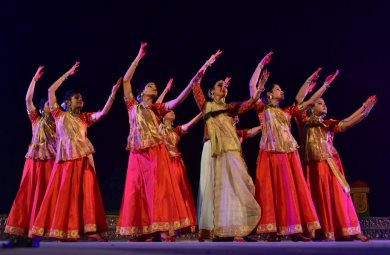 Yasmin Singh & group Not a familiar figure in the dance circuit, Yasmin Singh of Chattisgarh, after training under Arjun Mishra and Vaswati Mishra in the Lucknow gharana Kathak, has trained in the Raigarh Gharana under Kartik Ram and Kalyan Mahant, with compositions of Raja Chakradhar Singh of Raigarh an inevitable part of the learning. Trying to bring into greater focus the Raigarh Gharana, through group presentations suiting the contemporary context, has been the laudable effort of Yasmin - a task that the hitherto quietly efficient solo dancers have not tried their hand at in this school of Kathak. And barring the odd solo presentation, this Gharana has remained in the hinterland. Beginning with homage to Surya riding his chariot drawn by seven horses, Yasmin and her group presented fleeting vignettes representing divine Krishna as butter stealer, as prankster, as saviour of devotees, as Govardhan Giridhari and as "modern lover" (as announced) ending with the "Adharam Madhuram" shloka. Though the dancers were graceful, with good movement profile in technique and showed fair group synchronisation, what was missing in these group images was the weight of a classical performance - with not even a hint in the performance of any type of virtuosity, which is the very fabric of Kathak nritta. The group form also takes away from the depth and essence of the sahitya- which is what happened in the last part devoted to the Raigarh gharana with a Chakradhar Singh "Gori tore naina salore". Meant for in depth abhinaya, the dancers with the borders of the blood red ghagra (worn under the gold coloured overskirt) flaring out during chakkars, created a visual treat. But the emotive aspect of a line like "Chakra piyaki prema nibhara" and accent on the naina or eyes which the words speaks of, were lost. The concluding part with the music gradually melding into the nagma, with some nritta was more in keeping with the Kathak identity- but too little too late. Much like the others, with a large musical team with a host of instruments including the keyboard, and voices in chorus, the inflated music too erred in high decibel level, and as usual with the open air playing truant with the shruti of stringed instruments, with too many participants, immaculate sur control was missing. 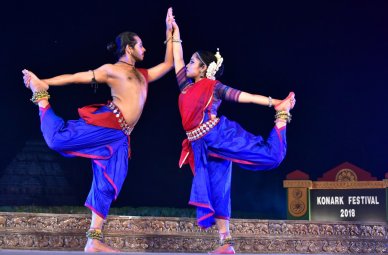 Sharmila Biswas group Sharmila Biswas is a dancer who has looked for new ways of expression in Odissi by delving further into forgotten nuggets of old art and literature belonging to rural Odisha. The opening with the Sabda Swara Patha from Kumhar village, evoking the Shiva/Parvati tandava /lasya moods with music composition by Ramahari Das and Dhaneswar Swain's nritta inputs, showed the high creative imagination in Sharmila's choreography which had the large performance space filled by the strength and aura of presence, rather than numbers. The movements of a twosome spun out in slow heady majesty, while rooted in the true Odissi character, were far from the conventional patterns in Odissi - with the male dancer's tandav ecstasy (Krishnendu Saha) ideally contrasted by (Parvati's) sensuality and grace (Rohini Banerjee and Monani). Moving in unison and separately, complemented by three other dancers by the side in a group, the perfection of slowly changing postures and positions of the group saw a gradual unfolding with surprising formations. After the patha, music took on the refrain "Tam thai taka thai taka taka inda thai..." with the dancers executing movements in immaculate perfection. The next composition named after the raga of its music scored by Debashish Sirkar - Kalashri - highlighted the basic Odissi position of the chauka, and the refrain using the rhythmic syllables "Jham ta rita jena tajhamta ritajena" portrayed how movements flowing out of this base, expand into the larger vocabulary. Again the group of dancers performed with a sense of exhilaration. Sharmila has to be congratulated on the kind of training given to the students, particularly the males who dance as males expressing whatever mood is called for. The next item Shingar/Sringar, aimed at recapturing a moment in the ekanta seva of the Mahari closeted with the idol of Jagannatha. Adorning her own body she loves, she offers it in full adoration and sringar to the beloved Jagannatha. The lyric "Jooda bandhiro" one has often heard, is attributed to Mukta Mahari. To conclude this, was the ecstasy and celebration of Moksha rendered to the accompaniment of the Ghanta Mardala. With musicians like Rupak Kumar Parida and percussionist like Bijay Barik, the music, unlike most groups, with Sharmila herself conducting, never erred in melodic control. 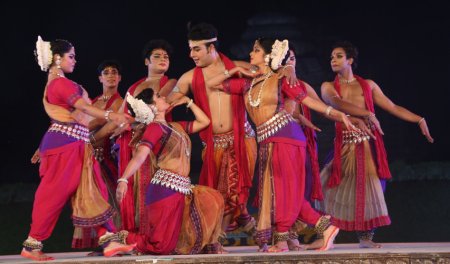 GKCM Odissi Research Centre Kavi Surya Baladev Rath's kavya Kishore Chandrananda Champu, has bestowed on Orissa the genre of music viz the Champu, its poetic content sung and extolled in dance too. While abhinaya items based on the Champu form a significant part of the Odissi repertoire, to structure an entire dance drama on this text, as envisaged by the present Director of Guru Kelucharan Mohapatra Odissi Research Centre, Sangita Gosain, is what led to Leela Madhuri, presented by the Research Centre. "Khuraputu hela re", "Golani to gola" and many others of the 36 compositions, each starting with a letter of the Oriya alphabet, have been heard and frequently danced. Now in the form of a dramatic Radha /Krishna love tangle, where important Champus establishing the story outline are used, what is first established is the context of this romance of Radha and Krishna under the Kadamba tree on the banks of the Yamuna. The dance, particularly when Krishna with four male companions or Radha with an equal number of her sakhis took the stage was neat. But a very large group, even when rendered by a well trained group of performers, faces its own choreographic challenges in using space on the expansive stage. When all of them in a closed straight line advance to the front of the stage, one wonders what happens to the rest of the vast space in the hinterland. With Nabakishore Misra, Yudhisthir Nayak and Lingaraj Swain directing or shaping the dance scenes, there was no uniformity of approach. In the final sequence, when all love tangles are sorted out by sakhi Lalita, portraying Radha and Krishna on the swing (the jhoolan scene not related to Kavi Surya Baldev Rath's text), with the Tarejham Pallavi in Shankarabharanam was not a bad idea- though the entire effort requires more evolving with one person directing, for this composition to acquire more sophistication. In the Krishna role was a fine dancer, who however like most male dancers in Odissi, needs to fight stomach flab. Notwithstanding expert musicians, the too large team more like an orchestra, with too many voices, female and male, when amplified, sounded unsynchronised or shrill in turns - even fine singers like Sangita Goswain losing out in the medley. One does not need an orchestra but a small team for music. 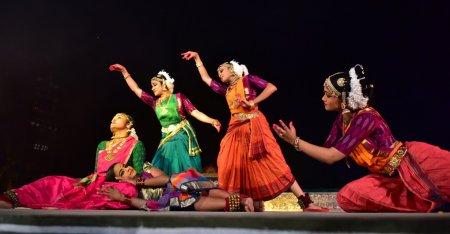 Sreelakshmy Govardhanan & group It is not surprising that an MSC in psychological counselling pursuing a degree in Hypnotherapy, Sreelakshmy Govardhanan, heading Avantika Space in Kerala, should inject a contemporary woman's voice into her traditional Kuchipudi, for which she trained under Rattiah Sarma and Vyjayanthi Kashi. Her group of young students, while painstakingly trained, provided a frame for the solo skills of Sreelakshmy which constituted a large part of the recital. The starting exhortation for 'Shanti' all over the Universe and the Balamurali Kriti in Arabhi in homage to Vighneswara, Hanuman and Krishna were followed by the central part of the recital Soorpanakha, who watching Lanka reduced to rubble, and brother Ravana lying dead, with her entire clan being wiped out, questions fate and the treatment and disfiguring meted out to her by Rama and Lakshmana. "Na dosham emi" - What is my fault - just falling in love and expressing it? Is that a sin? The words set to the most stirring score by Hyderabad's D.S.V. Sastri (in known and rare ragas Charukesi, Vijayanagari, Vasanti, Mohanangi and Dhenuka) was expressed through mature internalised abhinaya by Sreelakshmi (though for this large open area, the sringar scene portraying her smitten feelings for first Rama and then Lakshmana, while very movingly expressed, should have been edited). The final question, with all the angels of the forest sympathising but moving away from her, barring the youngest who lies down with her head on Shoorpanakha's lap, is posed to the audience, with the unalloyed directness of a liberated woman. Balamurali's Kuntalavarali Tillana rendered in a group brought down the curtain on the recital. Despite a melodious singer in Murali Sangeet with nattuvangam support by Suresh Kumar, and flute by Vinod, the poor sound balancing made the violin by Shyam Kalyan so overpoweringly loud that it drowned the rest of the music - the decibel level leading to a shrillness robbing the music of all melodic sweetness. 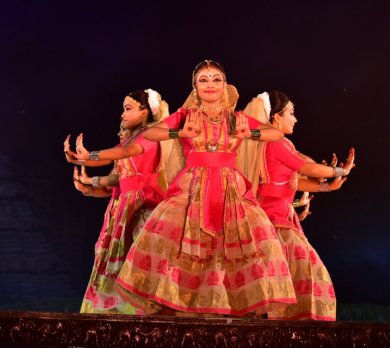 Anwesa Mahanta & group That two worthy performers can fill up a large stage space with their presence was shown in the Sattriya Gayan Bayan by Hariprasad Saikia and Devajeet Saikia on khol and large cymbals respectively. The tonal music and clarity of rhythm on the khol, with hands simultaneously moving in different hastas and feet providing rhythm in typical Sattriya gaits, made for a perfect Poorva Ranga. Appearing on the horizon stepping from the temple tower at the back of the stage with the lighting showing the rays of the Sun as it were, came the five dancers led by Anwesa Mahanta for the invocation with the quietude of "Namo Namo Jagannatha" based on a Kirtana from Sankaradeva's Kirtana Ghosha from the chapter Oresa Barna, followed by the typical Sattriya namaskar. The minimal movements executed with deliberate slowness, the dancers clad in pink and white ghagras and top, exuded a quiet energy filling up space. Vandana ended with pure dance in Sali Nach with all its grace. Next came the centrepiece of Dasha Lakshana based on the Bhagavata Purana, the dance narrative following the manner of Sankaradeva's teachings, as the Bhagabati recites (a tradition existing, it is said, to this day) through special anecdotes propounded for each of the principles illustrating the devotee's relationship with the almighty. While scenes of Creation with the five elements of the Cosmos (Sarga), the Purusha/Prakriti stances of Sattriya, used as a metaphor for representing Sthana or where one is placed in rebirth according to one's karma, the Gajendra moksha scene illustrating Manvantara or acceptance of one's place in the rebirth like Hiraksha and Hiranyakashipu being born as Gajendra and the crocodile respectively, a flash of the Narasimha avatar in Ishana were all communicative. But there was a great deal of abstraction - like pirouettes expressing the formless Reality and curves and turns expressing the opposite in Narankara-Akara, and hand gestures representing chorus and dancers in front showing the constant mental flux - which were too will-of-the-wisp to be communicated. All one took in was the generally well-spaced clean dancing with the import of details and related sequences lost. The khol accompaniment was superb and the singing supportive. Wisely it was a small group of accompanists. Poshana (grace bestowed on devotees), Atmajnana with removal of the ego, Uti (strength and sagacity), Ashraya and Mukti were communicative in a general sense representing a feel of beatitude. 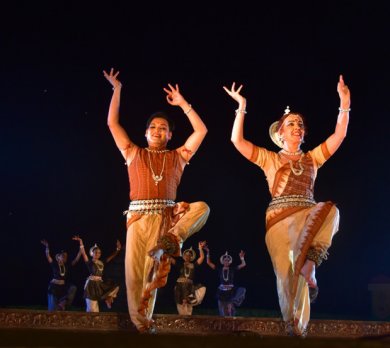 Ileana Citaristi & group While fully accepting a dancer's liberty and dancer Ileana Citaristi's sense of adventure in anchoring Odissi to original themes outside the Guru given repertoire, I must confess to a feeling of unease at her new production on the subject of Refugee in the Konark context, while accepting that the issue of victims of violence roaming the world for a space they can call home, holds immense emotional potential for exploration in all forms of art expression. But on this stage and occasion, the rendition based on the poems of Devdas Chhotray seemed out of place and could not generate the bite to hold audience attention. The artist's concern, taking on a monochromatic tone of tragedy in the treatment, over simplifies what is a complex human dilemma. The letter to the addressee who no longer has a home to call his own, returns to the sender - for whether desert, starless sky or black water, the hapless people on this ship without a sail or oars represent a journey to nowhere. A screen of smoke blocks the vision of a future and as one thinks fondly of the mother's warm embrace and hands locked in love, wishing that the milk of human kindness removes bonds between man and man. If only "love is not carved by geography nor controlled by geometry" sounds great in poetry. But how does one translate it into the language of throbbing dance movement? Music by Laxmikanta Palit had that unsettling timbre, in its mixed tones, the nondescript identity suiting the theme. With Ganga/Jamuna, the next duet with Ileana and Saswat Joshi, based on Kalidasa's verse from the Raghuvamsha describing the coming together of two rivers with very different characteristics, the viewer was once more on familiar territory. The dance reverted to scenes from "Bhinna Pravaha" when Ileana participated in Chandralekha's composition. Again, the sound balancing and the music of even Gopal Chandra Panda with Sangeeta singing, left much to be desired. This is an issue which in the open air needs to be studied for it tends to spoil carefully rehearsed programmes. 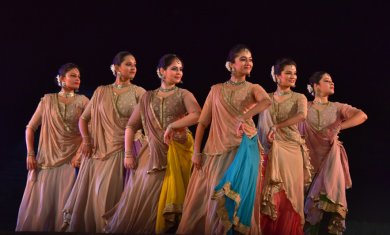 Kadamb group In presentation aesthetics, there are few to compare with Kathak expert Kumudini Lakhia. The recital by the group from her institution Kadamb, led by Sanjukta Sinha her senior disciple, in sheer mastery of Kathak technique and nritta took one's breath away. If the Shakti Stuti portrayed the panache and flair of the female dancers Vidhi Shah, Krutika Gharekar, Rupanshi Kashyap and Mansi Gandhi, Dhamar marked male virtuosity of incredible dimensions, the 14 matra bandishes by each of the four male dancers Dheerendra Tiwari, Mohit Sridhar, Rohit Parihar and Sanjeet Gangani (trained by other Gurus but guided by Kadamb for this programme) scintillating in execution and ease of doing the most difficult steps. With Sanjukta also appearing, here was a perfect demonstration of how group Kathak could preserve the nritta high points while keeping presentation artistry in mind. While teental by female dancers had a lyrical quality in movement, the lyric "Barse badariyan savanki" while full of group images associated with the monsoons like the peacock, lost out on abhinaya - which did not have due place in the entire recital. The Tarana finale in Puryadhanashree was again delightful. A small and efficient musical team had tabla by Joby Joy, sarangi by Ikram Khan Kalawant, and vocal support by Praher Vora with flute by Partha Sarkar. Elegantly tailored costumes in delightful colours while very artistically designed, evoked the reaction of being 'too bold' by more conservative viewers. 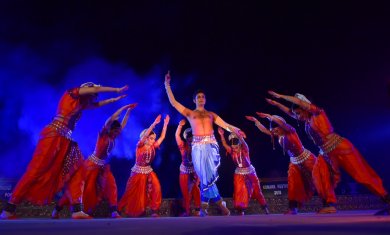 Ranjana Gauhar's group The last group constituting the disciples of Ranjana Gauhar from Delhi presented Matsya Avatar. A very skeletal story in the Dashavatar episodes, Matsyavatar needs to be bolstered by fillers for a full length presentation. And the choreographer Ranjana achieved this by just the chant 'Om Narayana, Matsya Narayana' in the start setting the mood with frozen stances of the Matsya Avatar. Aghast at Hayagriva's stealing of the Vedas, gods approach Vishnu, who is urged to take on another manifestation to rescue the sacred literature revealed to Brahma. Taking the form of a fish, Vishnu rescues the Vedas from the depth of the ocean. "Pralaya prayodhijale dhrta vanasi vedam" the first verse of the opening song of Jayadeva's Gitagovinda was part of the salutation along with the Vishnu Sahasranamam verse "Parithranaya sadhoonam, vinashaya cha dushkrtam sambhavami yuge yuuge" carrying the declaration of the Almighty that every time evil overpowers good, he will manifest on earth to re-establish the power of good by crushing evil. Along with this was the Pallavi in Keerwani. What remained was the appearance of Hayagriva who was depicted through the strong movements of Chhau. The libretto was in a combination of Hindi and Sanskrit and Suraj Sethi's music used simple ragas like Mohanam, Malkauns, with the final Pralaya prayodhijale in Bhairavi. Prafulla Mangaraj (mardal), Saroj Mahanta (vocal), Abhiram Nanda (flute), gave adequate support. The male characters were well selected and the students danced with well defined lines and with synchronicity. Music while not brilliant was adequate. With the International Hockey Tournament on in Bhubaneswar, the audiences for Konark Festival were less than seen last year.  Writing on the dance scene for the last forty years, Leela Venkataraman's incisive comments on performances of all dance forms, participation in dance discussions both in India and abroad, and as a regular contributor to Hindu Friday Review, journals like Sruti and Nartanam, makes her voice respected for its balanced critiquing. She is the author of several books like Indian Classical dance: Tradition in Transition, Classical Dance in India and Indian Classical dance: The Renaissance and Beyond. Post your comments Please provide your name and email id when you use the Anonymous profile in the blog to post a comment. All appropriate comments posted with name & email id in the blog will also be featured in the site. |